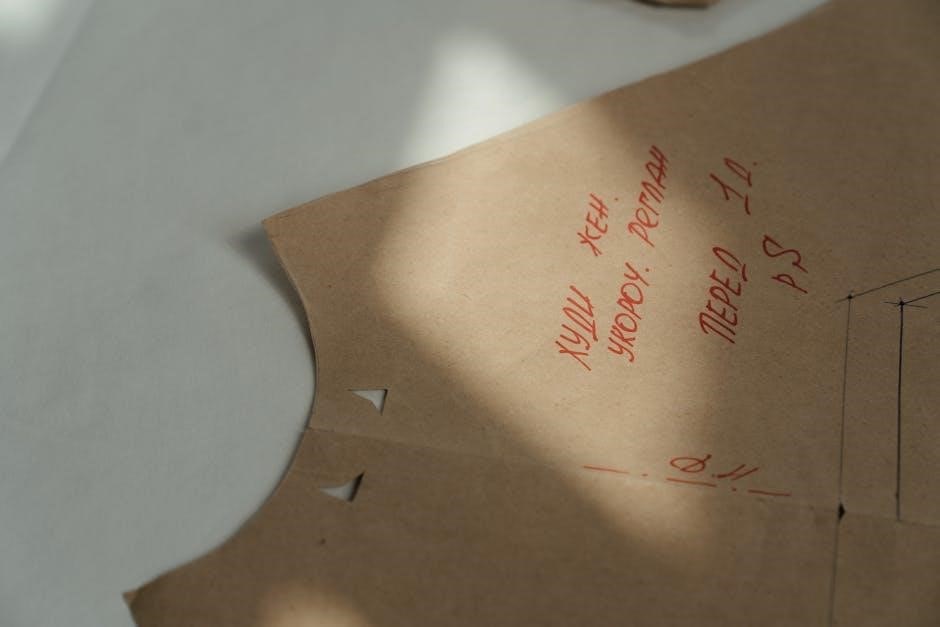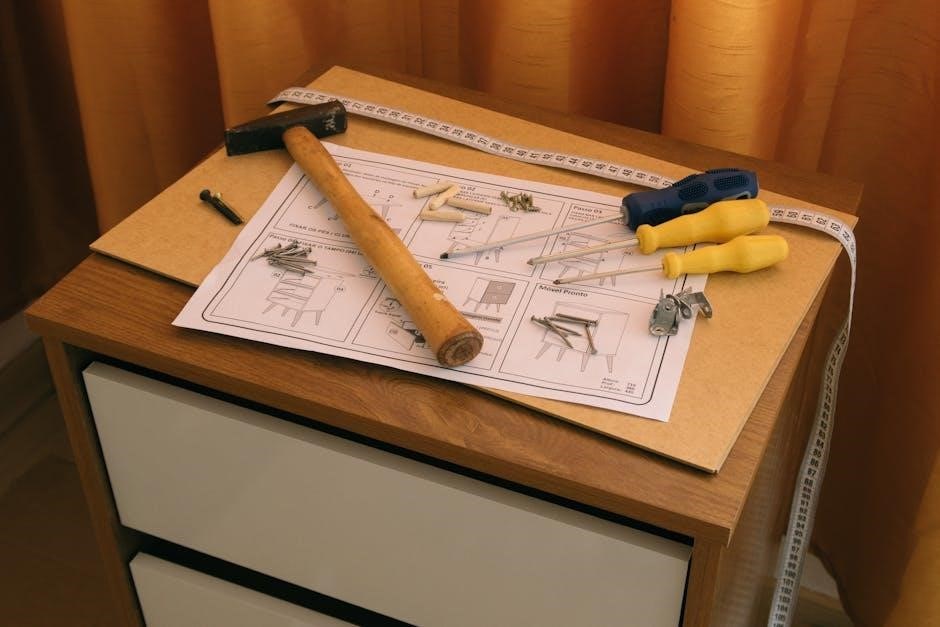Bissell CrossWave Instructions Manual PDF: A Comprehensive Guide
Welcome to your comprehensive guide to the Bissell CrossWave! This manual, available in PDF format, provides detailed instructions for optimal use. Master assembly, water tank filling, mode selection, and essential techniques. Learn to tackle stubborn messes effectively and maintain your CrossWave properly for lasting performance.
Assembly and Initial Setup
Embark on your cleaning journey by properly assembling your Bissell CrossWave. Begin by carefully sliding the handle into the main body of the unit until you hear a reassuring “click,” signifying a secure connection. This ensures proper control and maneuverability during operation. Next, familiarize yourself with the components and their respective functions, referencing the included diagrams for clarity.
Before the first use, inspect all parts for any potential damage sustained during shipping. If any issues are identified, contact Bissell customer support immediately for assistance. Ensure the area where you intend to operate the CrossWave is clear of any obstructions or hazards. This initial setup is critical for optimal performance and longevity.
For cordless models, fully charge the unit using the 3-in-1 docking station. A full charge typically takes around four hours, so plan accordingly. During the charging process, the indicator lights will provide feedback on the battery status. Avoid using the CrossWave during the charging phase to prevent any potential issues. Complete the initial setup properly to unlock the cleaning potential of your new CrossWave.
Filling the Clean Water Tank

Properly filling the clean water tank is essential for effective cleaning with your Bissell CrossWave. Locate the clean water tank, usually at the back of the machine, and remove it. Consult your CrossWave model’s specific manual for the exact tank location and removal process. Open the tank’s fill opening and add water to the indicated fill line. It’s crucial not to overfill the tank, as this can lead to leaks or operational issues.
For best results, use only genuine Bissell cleaning formulas designed for your CrossWave. Adding the appropriate amount of formula to the water tank enhances cleaning performance and protects internal components. Refer to the formula bottle and your CrossWave manual for the correct water-to-formula ratio. Using too much or the wrong formula can damage the machine or leave residue on your floors.
Once you’ve added water and formula, securely close the fill opening to prevent leaks. Slide the filled tank back into the machine until you hear a click, ensuring it’s firmly in place. Always use cold or lukewarm water to fill the tank. Using hot water can potentially deform the tank and impact the machine’s performance. With the clean water tank properly filled, your CrossWave is ready to tackle dirt and grime.
Understanding Cleaning Modes: Hard Floor vs. Rug

The Bissell CrossWave offers distinct cleaning modes tailored for either hard floors or rugs, optimizing cleaning performance and preventing damage. Selecting the correct mode ensures the appropriate brush roll speed and solution dispensing for the surface being cleaned. Using the wrong mode can lead to ineffective cleaning or potential harm to your floors or rugs.
The “Hard Floor” mode is designed for sealed hard surfaces like tile, laminate, and hardwood. In this mode, the brush roll spins at a higher speed to effectively scrub away dirt and grime. The solution dispensing is also calibrated for hard floors, providing the right amount of moisture without oversaturating the surface. Always ensure your hard floors are sealed before using this mode to prevent water damage.
Conversely, the “Rug” mode is specifically for area rugs and low-pile carpets. This mode features a slower brush roll speed to gently lift dirt and debris without damaging rug fibers. The solution dispensing is also reduced to prevent over-wetting the rug. Before cleaning any rug, check the manufacturer’s instructions to ensure it’s suitable for wet cleaning. Always test a small, inconspicuous area first to check for colorfastness before cleaning the entire rug.
Operating Procedures and Techniques
Mastering the operating procedures and techniques for your Bissell CrossWave ensures efficient and effective cleaning. Before starting, always ensure the clean water tank is filled with the appropriate solution and the dirty water tank is empty. Select the correct cleaning mode – hard floor or rug – depending on the surface you intend to clean. Plug in the CrossWave or, if cordless, ensure it’s adequately charged.
To begin cleaning, recline the machine to activate the brush roll. Engage the solution spray trigger while moving forward and backward over the area, applying a consistent stream of cleaning solution. Avoid holding the trigger continuously to prevent over-wetting the floor. Overlap each cleaning pass slightly to ensure complete coverage. For optimal results, move at a slow and steady pace, allowing the CrossWave to effectively lift and remove dirt and debris.

When cleaning edges and corners, use short, deliberate strokes to reach tight spaces. Regularly empty the dirty water tank to maintain suction power and prevent overflow. After cleaning, run the machine on the storage tray to clean the brush roll and minimize odors. Proper technique maximizes the CrossWave’s cleaning capabilities and extends its lifespan.
Cleaning Stubborn Messes
Tackling stubborn messes with your Bissell CrossWave requires a focused approach and specific techniques. For dried or sticky spills, pre-treating the area is often beneficial. Apply a small amount of Bissell cleaning solution directly to the mess and let it sit for a few minutes to loosen the grime. When using your CrossWave on stubborn messes, hold it over the area while engaging the spray trigger.
Utilize short, overlapping passes while continuously applying the cleaning solution. The multi-surface brush will work to scrub and lift the mess. If the CrossWave leaves too much water on the floor, release the spray trigger and make additional passes to dry the area; For particularly tough spots, consider using the CrossWave on the hard floor setting, even on rugs, as this provides more aggressive cleaning action.
Always ensure the dirty water tank is emptied frequently when dealing with significant messes to maintain optimal suction. After cleaning, thoroughly rinse the brush roll and allow it to air dry to prevent residue buildup. With the right technique and persistence, your CrossWave can effectively eliminate even the most challenging messes, leaving your floors clean and fresh.
Proper Maintenance and Cleaning of the CrossWave
Maintaining your Bissell CrossWave is crucial for its longevity and optimal performance. Regular cleaning of the components ensures efficient operation and prevents the build-up of dirt and debris. After each use, empty the dirty water tank and rinse it thoroughly with clean water. This prevents odors and the growth of bacteria. Disassemble the brush roll and clean it under running water, removing any hair or fibers that may be tangled around it. Allow all parts to air dry completely before reassembling.
The filter should also be cleaned regularly, typically after every few uses. Remove the filter, tap it gently to remove loose dirt, and rinse it under water. Ensure the filter is completely dry before placing it back into the machine. Periodically wipe down the exterior of the CrossWave with a damp cloth to remove any spills or splatters.
Check the spray nozzle for any clogs and clear them with a small pin if necessary. Store your CrossWave in a dry place, preferably on its docking station or storage tray, to protect it from damage. Following these maintenance steps will ensure your Bissell CrossWave remains in excellent condition and continues to deliver exceptional cleaning results for years to come.
Troubleshooting Common Issues: Loud Noise, Leaks
Encountering issues with your Bissell CrossWave can be frustrating, but many common problems have simple solutions. If your CrossWave is producing a loud or excessive noise, the first step is to check the brush roll. Hair, debris, or tangled fibers can cause the brush roll to vibrate and create a loud noise. Remove the brush roll and thoroughly clean it, ensuring all obstructions are cleared. Also, inspect the floor nozzle for any blockages that might be causing the noise.
Leaks are another common concern. Check the clean water tank and the dirty water tank to ensure they are properly seated and sealed. Cracks or damage to the tanks can also cause leaks, so inspect them carefully. Make sure the tanks are not overfilled, as this can also lead to leaks.
If the CrossWave is leaking from the bottom, check the brush roll window for proper installation. If problems persist, consult the troubleshooting section of your manual or contact Bissell customer support for assistance. They can provide further guidance and help resolve any issues you may be experiencing. Regular maintenance helps prevent these problems.
Charging the Cordless Models

Maintaining the battery of your Bissell CrossWave cordless model is crucial for optimal performance and longevity. To charge your CrossWave, start by placing the machine securely onto the 3-in-1 docking station. Ensure the docking station is plugged into a functioning electrical outlet. The docking station serves not only as a charging base but also as a convenient storage solution for your CrossWave.
A full charge typically takes around 4 hours, so it’s best to allow ample time for the battery to reach its maximum capacity. While charging, the indicator lights on the machine will illuminate, showing the charging progress. Once fully charged, the indicator lights will typically remain solid or turn off, depending on the specific model.
Avoid leaving the CrossWave on the docking station for extended periods after it’s fully charged, as this can potentially reduce the battery’s lifespan over time. It’s also recommended to avoid completely depleting the battery before recharging, as this can also impact its overall health. For more detailed information on charging and battery maintenance, refer to the charging section of your CrossWave manual.
Safety Instructions and Precautions
Prior to operating your Bissell CrossWave, carefully review all safety instructions and precautions outlined in the user manual to prevent potential hazards and ensure safe usage. Always connect the CrossWave to a properly grounded outlet, avoiding the use of extension cords whenever possible to minimize the risk of electrical shock or fire. Never modify the plug in any way.
Do not operate the appliance if it has a damaged cord or plug. Unplug the CrossWave from the electrical socket when it is not in use and before performing any cleaning, maintenance, or servicing. This appliance can be used by children aged 8 years and above and persons with reduced physical, sensory, or mental capabilities if they have been given supervision or instruction concerning the use of the appliance in a safe way and understand the hazards involved.
To reduce the risk of fire or explosion, do not use flammable or combustible liquids with this appliance. Always use genuine BISSELL formulas designed for wet and vacuum cleaning to reduce possible damage to internal components and optimize performance. Do not immerse the appliance in water or other liquids.

No Responses